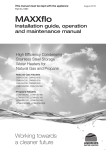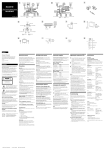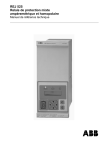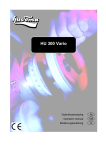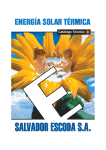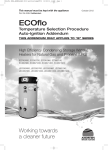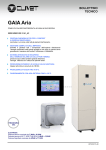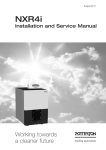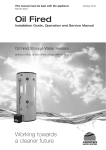Download Baxi Solarflo Installation manual
Transcript
This manual must be kept with the appliance Part No. S159 SOLARflo Installation manual Working towards a cleaner future May 2011 © Copyright Andrews Water Heaters 2009 Reproduction of any information in this publication by any method is not permitted unless prior written approval has been obtained from Andrews Water Heaters. Andrews Storage Water Heaters have been designed and manufactured to comply with current International standards of safety. In the interests of the health and safety of personnel and the continued safe, reliable operation of the equipment, safe working practices must be employed at all times. The attention of U.K. users is drawn to their responsibilities under the Health and Safety Regulations 1993. All installation and service on the Andrews Water Heater must be carried out by properly qualified personnel, and therefore no liability can be accepted for any damage or malfunction caused as a result of intervention by unauthorised personnel. The Andrews Water Heaters policy is one of continuous product improvement, and therefore the information in this manual, whilst completely up to date at the time of publication, may be subject to revision without prior notice. Further information and assistance can be obtained from: Andrews Water Heaters Wood Lane, Erdington Birmingham B24 9QP Tel: 0845 070 1056 Fax: 0845 070 1059 Email: [email protected] Website: www.andrewswaterheaters.co.uk GENERAL INFORMATION SECTION 1 SECTION 2 SECTION 3 SECTION 4 SECTION 5 PAGE GENERAL DESCRIPTION AND INTRODUCTION General Information Equipment Description System Schematics Basic Operation 2 3 4 5 TECHNICAL SPECIFICATION Overall General Specification 7 INSTALLATION Pipework Solar Collectors Solar Station Wiring & Panel Domestic Hot Water Top Up & Primary 9 11 15 17 21 23 TECHNICAL INFORMATION Technical Information Solar Collectors Solar Water Cylinders Solar Station 25 26 28 29 CHECK LIST Checklist 30 SECTION 1 GENERAL DESCRIPTION AND INTRODUCTION GENERAL The SOLARflo systems have been designed and selected to offer a complete solar package INFORMATION to provide Domestic Hot Water (DHW) with maximised contribution from solar irradiation for commercial systems. The systems offer solutions for a variety of applications, to deal with the larger applications associated with commercial systems as well as dealing with higher storage temperatures and legionella. The systems break down into equipment sub-sections: THE SOLAR SIDE The Solar Collectors. A Controller to control the solar gain and integrate the ètop upê heating. Solar pumping system Solar pipe-work ancillary equipment including expansion system. THE DHW SIDE The DHW generation and storage system Destratification/anti-legionella pumping system DHW expansion system Cold water feed equipment Primary heating system DHW top up system (Pre-heat system only) Various systems can be designed to best suit operation of the package. The system will then determine what equipment is required. The type of equipment will then determine the operation and installation requirements. Andrews Water Heaters, offer a standard simple system based on single solar field, single vessel (see Fig 3). However alternative systems are available to best suit the application. EQUIPMENT SELECTION: The equipment selection can be based upon duty and operation. Andrews Water Heaters offer a set of standard packages to cover a large percentage of requirements based on a simple solar thermal system. SEE TABLE OPPOSITE FOR A GENERAL INDICATION OF EQUIPMENT DESCRIPTION AND SELECTION POSSIBILITIES. THE TABLE ALSO SHOWS THE SCOPE OF STANDARD SYSTEMS ONLY. The packages are split into pre-heat system with a single coil unit and combined system with a secondary coil. SYSTEM SELECTION. Alternative systems are available and are discussed in the operation section of this manual. Any specific information will be supplied with the package. Other systems available on the SOLARflo systems include, multi-vessel, multi-solar field, plate heat exchanger systems, dump valves. 2 EQUIPMENT DESCRIPTION SECTION 1 REF CIRCUIT EQUIPMENT 1 SOLAR Solar collectors GLAZED FLAT PLATE Collects both direct and diffuse solar radiation and transfers it to the water medium. GLAZED FLAT PLATE: Insulated frame with copper pipe-work welded to an absorbtion plate. This is covered with special glass (with low thermal expansion co-efficient) to allow maximum radiation to pass through but to limit heat loss. 2 SOLAR A controller to control the solar gain and intergrate the 'top up' heating. A specific controller designed to offer pump control and temperature sensing to allow solar heat collection. Its main function is to check difference between storage and collector; temperatures to decide when heat gain is achievable. This controller however also covers many other functions including primary heating and legionella control. 3 SOLAR Solar pumping system Comprising solar pump, mounting pipe-work, flow regulator, air eliminator, isolation, relief valve and connections for the expansion line. This is generally combined with the pipework ancillaries and expansion vessel to form the ANDREWS SOLAR STATION. 4 SOLAR Solar pipe-work ancillary equipment including expansion system. The interconnecting pipe-work is supplied and fitted by the installer. The connecting pipework on the 'Solar Station' is supplied and factory fitted by Andrews Water Heaters. This also includes the solar expansion vessel (to absorb expansion due to temperature and vapourisation of fluid within the Solar Collector), drain/vent/fill connection and optional automatic air eliminator. 5 DHW The DHW storage cylinder(s) SINGLE COIL PRE-HEAT or TWINCOIL COMBINED This will be either a PRE-HEAT (single coil) OR A TWIN-COIL COMBINED CYLINDER. It comprises a stainless steel cylinder either the one lower coil or twin coils (higher and lower). The lower coil transfers the heat from the solar circuit. The higher coil (where supplied) heats the upper section using primary heat at 82∫C or an immersion heater. Where no top heater is used the DHW water passes to another heating 'top up' system. 6 DHW DHW expansion system Expansion veseels sized to accomodate the expansion due to temperature increase. The equipment also includes expansion relief valve and lockshield valve. 7 DHW De-stratification/antilegionella pumping system A DHW pump with valves. On a twin-coil cylinder destratification loop the pipe-work connects the top of the cylinder to the bottom. It is designed to take the whole cylinder up to a temperature and eliminate stratification. In a single coil unit the bottom coil of the cylinder is connected to the DHW outlet of the primary DHW heating system. 8 DHW Cold feed equipment Consisting strainer isolation and check valve (possibly combined). Fitted to the cold water inlet supplying the DHW vessel. 9A PRIMARY SYSTEM This can be a variety of equipment either supplied as part of a package or supplied by others. This can vary from no primary system, to a direct fired water heater, a single primary actuator to a full primary boiler system with seperate controls. It is designed to supply primary hot water as 'top up'/back up to the solar heating. In general it can be a complete system of it's own. 9B DHW TOP UP This equipment is used when a PRE-HEAT DHW cylinder is used. This can be a variety of equipment designed to heat the DHW to required water temperature. This can be used in conjunction with the primary heating system. 3 SECTION 1 GENERAL DESCRIPTION AND INTRODUCTION COLLECTOR SENSOR SYSTEM SOLAR COLLECTOR PANELS SCHEMATICS FIG 1 SOLAR CONTROL PANEL SECONDARY RETURN PUMP SOLAR PUMP STATION NON-RETURN VALVE TEMPERATURE / PRESSURE RELIEF VALVE 7 BAR / 95ºC FLOW COMMISSION & FILLING VALVE HI-LIMIT STAT SOLAR EXPANSION VESSEL PRE-HEAT SOLAR VESSEL MAXXFLO WATER HEATER ANTI-LEGIONELLA CIRCUIT & PUMP (TIMED) NON-RETURN VALVE FLOW HOT WATER OUTLETS EXPANSION VESSEL DRAIN COCK NON-RETURN VALVE EXPANSION RELIEF VALVE 6 BAR COLD WATER SUPPLY STOP PRESSURE LIMITING & LINE COCK STRAINER VALVE 3½ BAR D COLLECTOR SENSOR SOLAR COLLECTOR PANELS SOLAR CONTROL PANEL SOLAR PUMP STATION TEMPERATURE / PRESSURE RELIEF VALVE 7 BAR / 95ºC HOT WATER OUTLETS FLOW COMMISSION & FILLING VALVE LOW LOSS HEADER HI-LIMIT STAT SOLAR EXPANSION VESSEL HEATING BOILER TWIN COIL VESSEL NON-RETURN VALVE EXPANSION VESSEL DRAIN COCK SECONDARY RETURN PUMP NON-RETURN VALVE EXPANSION RELIEF VALVE 6 BAR D 4 PRESSURE STOP LIMITING & LINE COCK STRAINER VALVE 3½ BAR COLD WATER SUPPLY GENERAL DESCRIPTION AND INTRODUCTION SECTION 1 BASIC OPERATION: (SEE FIG 1) Solar irradiation energy incident on the the solar collectors is transfered (in the form of heat energy) to the solar circuit fluid. The circuit fluid is pumped around the system, transferring this heat energy to the storage cylinder, indirectly via a coil. In Glazed Flat Plate Collectors heat is transferred to copper pipes carrying the heat transfer fluid with the assistance of an absorber plate. This is located within an insulated frame with a glass cover. This allows solar radiation to pass through but limits the heat lost through convection and conduction. COLLECTORS The fluid is transferred around the circuit by a pump. This is switched on, when the temperature or the surface of the collector absorber (for glazed flat plate collectors) or the fluid exit temperature (for evacuated tube collectors) is greater (by a fixed differential) than the solar portion of the DHW cylinder. The energy from the collectors will be transferred to the water in the storage cylinder. As the solar circuit is a closed system expansion vessels and relief valves are required. The collectors are generally arranged in FIELDS (an array of collectors). Each field located differently to maximise the irradiation collection throughout the day as the sun èmovesê through the sky. Normally only one field is used placed in the optimum position. Multiple fields are used when a more even heat gain is required throughout the day, space is limited or where not one available location is ideal. FIELDS The solar irradiation can not always supply the DHW required at times of demand. Also dependant on time of the day or month of the year there could be no solar contribution. A ‘top up’ system ensures that there will always be DHW available at the correct temperature. ‘TOP UP’ The ‘top up’ system must always be sized on the basis of no solar contribution being available to ensure the DHW demand can be satisfied. We have two types of systems for utilising ‘top up’, combined and pre-heat: COMBINED SYSTEM In a combined system (twin coil/immersion heater) the same cylinder is used to reach the desired water temperature via two coils. A lower coil is used to transfer the solar heat to the lower section of the cylinder, a higher coil heats the upper section using high grade heat from, for example, a heating system or an electric immersion heater. In the SOLARflo systems a full primary heating system can be included, utilising dedicated or non-dedicated boilers. If a primary system is already available this can be diverted via a pump, or valve or an immersion heater installed. The SOLARflo system can offer control/communication of this primary section in order to maintain the water temperature within the cylinder. 5 SECTION 1 GENERAL DESCRIPTION AND INTRODUCTION PRE-HEAT In a pre-heat system the water in the cylinder is heated only by the solar. This is discharged SYSTEM to a secondary device e.g storage calorifier/direct-fired water heater. These can be supplied as part of the SOLARflo system. If the secondary device requires primary hot water a primary system can be included. The standard systems supplied with SOLARflo use direct gas fired water heaters. The ‘top up’ system is also required to ensure anti-legionella temperatures are reached and de-stratification measures can take place LEGIONELLA One of the main differences between commercial and domestic solar thermal systems is the requirements of L8, the control of legionella. Temperatures must be able to achieve 60°C and above. The ‘top up’ system must take the storage water to 60°C if the solar energy is not able to do so. DESTRATIFICATION Destratification quipment is supplied on both types of systems to ensure all the water within the cylinder is heated to anti-legionella temperatures. For pre-heat systems the water is taken from the outlet of the ‘top up’ system and fed to the bottom of the solar cylinder. For combined cylinders with twin-coils a destratification loop pumps hot water from the top of the cylinder to the lower section. CONTROL The controller is designed to integrate the whole SOLARflo system from solar pump control to operation of the destratification cycle. 6 TECHNICAL SPECIFICATION SECTION 2 OVERALL GENERAL SPECIFICATION OF THE SOLARflo SYSTEM. DESCRIPTION: SOLARflo MANUFACTURER: Andrews Water Heaters FEATURES TECHNICAL DETAIL: Vessel Sizes: 450, 550, 700, 900 (Litres) Max Flow Rate: (solar circuit) 30 l/min Max Pressure Drop:(solar circuit) See curve in pump station instructions Pressure: (solar circuit) Temperature: (solar system) Max 6bar(g) 120°C. Higher Temperatures will occur* Pressure: (dhw system) Temperature: (dhw system) Standard 3.5bar Operating 60°C Max 95°C Electrical: Controller 230V/1ph/50hz, 4Amps Pump station is powered and controlled by the controller. This does not include any immersion heaters. PT1000 Sensors: DHW Heating Vessels: Combined (twin coil or coil and immersion heater) Pre-heat (single coil) Top Up Systems for Preheat MAXXflo gas fired condensing water heater Primary Heating Valve control Enable signal Immersion heater (3kWe, 6kWe, 9kWe, 12kWe) Boiler system 7 SECTION 3 INSTALLATION PRIMARY Please refer to the Technical Specification Appendix for details of the individual equipment. SYSTEMS The overall specification sheet will indicate specific supply of the system supplied. GENERAL WARNINGS: The solar system should never be left with water in and not fully commissioned. If commissioning can not take place, the unit should be left with no water content or the collectors covered. Both circuits contain unvented systems. Please ensure all relevant relief valves and associated expansion equipment are fitted. This includes any equipment not supplied by Andrews Water Heaters. The installation should only be carried out by a competent person as per the Building Regulations. Solar collectors are both high temperature water and steam generators. Therefore high pressures and temperatures can be generated. The collectors and associated equipment have been designed for these conditions. However the collectors should be treated with precautions associated with high temperature/pressure systems. Full Health and Safety regulations should be followed for all aspects of installation. IMPORTANT INSTALLATIONS NOTES 1. ENSURE THE INSTALLATION IS CARRIED OUT AS PER THE APPROPRIATE SYSTEM SCHEMATIC AND THAT ALL EQUIPMENT IS INCLUDED AND INSTALLED CORRECTLY. 2. COLLECTORS ARE INSTALLED AT THEIR OPTIMUM ORIENTATION AND ANGLE TO MAXIMISE SOLAR CONTRIBUTION. SEE TECHNICAL SPECIFICATION SECTION. 3. ENSURE PIPE-WORK IS AN APPROPRIATE SIZE FOR FLOW RATES. 4. FOR COPPER PIPE-WORK ONLY BRAZED OR COMPRESSION/SCREWED CONNECTIONS SHOULD BE USED, APPROPRIATE FOR THE HIGH TEMPERATURES >215°C. 5. APPROPRIATE EXPANSION VESSELS AND RELIEF VALVES SHOULD BE INSTALLED ON BOTH SOLAR AND DOMESTIC HOT WATER SIDES OF THE SYSTEM. 6. THE SOLAR SYSTEM SHOULD ONLY BE FILLED USING THE SUPPLIED GLYCOL/WATER MIX. IT IS RECOMMENDED THAT THIS IS USED FOR TEST FILLS DUE TO THE DIFFICULTIES IN DRAINING DOWN THE ENTIRE WATER CONTENT IN THE COLLECTORS. 7. THE ANDREWS SOLARflo SYSTEM REQUIRES 230V, 4AMP (OTHER SYSTEMS MAY REQUIRE MORE). THE POWER SUPPLY TO THE CONTROLLER MUST BE ABLE TO BE ISOLATED CLOSE TO THE UNIT. A SEPERATE 230V PLUG SOCKET MUST ALSO BE AVAILABLE FOR COMMISSIONING. IF IN DOUBT ASK 8 INSTALLATION SECTION 3 PIPEWORK The equipment supplied by Andrews Water Heaters is designed to be easy to install due to its module supply. The interconnecting pipe-work is schematically shown in Fig 2. Fig.2 COLLECTOR SENSOR COLLECTOR SENSOR SOLAR COLLECTOR PANELS E SOLAR CONTROL PANEL SOLAR COLLECTOR PANELS E SOLAR CONTROL PANEL SECONDARY RETURN PUMP SOLAR PUMP STATION SOLAR PUMP STATION NON-RETURN VALVE TEMPERATURE / PRESSURE RELIEF VALVE 7 BAR / 95ºC TEMPERATURE / PRESSURE RELIEF VALVE 7 BAR / 95ºC FLOW COMMISSION & FILLING VALVE HI-LIMIT STAT SOLAR EXPANSION VESSEL PRE-HEAT SOLAR VESSEL HOT WATER OUTLETS FLOW COMMISSION & FILLING VALVE LOW LOSS HEADER HI-LIMIT STAT SOLAR EXPANSION VESSEL MAXXFLO WATER HEATER ANTI-LEGIONELLA CIRCUIT & PUMP (TIMED) HEATING BOILER NON-RETURN VALVE FLOW TWIN COIL VESSEL HOT WATER OUTLETS D NON-RETURN VALVE D EXPANSION VESSEL DRAIN COCK EXPANSION VESSEL DRAIN COCK A B NON-RETURN VALVE EXPANSION RELIEF VALVE 6 BAR D C A COLD WATER SUPPLY B SECONDARY RETURN PUMP NON-RETURN VALVE EXPANSION RELIEF VALVE 6 BAR PRESSURE STOP LIMITING & LINE COCK STRAINER VALVE 3½ BAR C COLD WATER SUPPLY PRESSURE STOP LIMITING & LINE COCK STRAINER VALVE 3½ BAR D Please refer to the individual equipment and relevant standards for full requirements of connection. All pipe-work must be suitable for potable water, this would be generally copper, a suitable grade of stainless steel, or plastic. DHW CONNECTIONS A,B,C SOLAR PIPE WORK IMPORTANT: Due to the potentially high temperatures in the solar circuit, suitable materials should always be used. Soft solder should not be used with copper, the pipe-work should be preferably brazed or compression fittings used. The number of joins should be limited. As the heat transfer fluid in the solar circuit contains a water/glycol mix it is recommended that the discharges of relief valves are not put to drain. The relief valve connection (located in on the pump station) should be connected back into the original fluid container (located o the back of the solar station).SEE SOLAR STATION. This is to prevent loss of the fluid to drain. All fittings are best placed on the return line from to the solar coil to the collectors. This ensures equipment is only exposed to the cooler temperatures within the circuit. STAINLESS STEEL FLEXIBLE PIPE: The stainless steel flexible pre-insulated pipe is available in sizes DN20, DN25 and DN32. This pipe is pre-insulated and is supplied with electrical wire for connecting the collector sensor to the solar control unit already intergrated. 9 SECTION 3 INSTALLATION CONNECTIONS: D,E Fig. 2 shows the required connections for standard supply (solid lines). The individual connection points can be seen in the installation instructions for the particular item of equipment. This will also show how to connect multiple collectors together. Connection D: This is the pipe-work in the vacinity of the solar station. The distance of this pipe-work is usually small and is therefore economical to use copper. If the distances are quite large in this area the resultant pressure drop has to be taken into consideration. Both the air eliminator (if used) and drain/fill valve should be fitted in the RETURN line. Connection E: This is the long flow and return line to the collectors and can run for many meters. For medium distances 20-30m and/or with many potential bends flexible pipe-work is recommended to reduce fitting time. For long straight runs copper is best used to reduce cost and the pressure drop. A combination of both will generally give the best results. INSULATION The stainless steel flexible pipe comes pre-insulated with insulation suitable for external use, is tolerant of high fluid temperatures and resistant to ultra-violet radiation. If this pipework is not used appropriate insulation has to be fitted and insulated appropriately with a UV stabe coating. VENT AND DRAIN Vent (SOLAR D & E) The SOLARflo system is designed not to require vents positioned in inaccessible high locations. A jet pump will be used to fill the system during commissioning by Andrews Water Heaters which will eliminate air within the system. WARNING: THE HEAT TRANSFER FLUID WITHIN THIS CIRCUIT CAN REACH HIGH TEMPERATURES CREATING HOT WATER AND STEAM. Drain A fill/drain valve is supplied with the SOLARflo system. This should be fitted at the lowest level of the system. If this is not used or cannot be installed in the lowest position, or the pipe-work is creates potential traps, extra drains should be installed. These should be HT fittings. SEE WARNING ABOVE REGARDING HIGH TEMPERATURES. 10 INSTALLATION SECTION 3 SOLAR COLLECTORS PLEASE REFER TO FULL INSTALLATION INSTRUCTIONS APPROPRIATE COLLECTORS AND MOUNTING EQUIPMENT. REGARDING The collectors should be only fitted by suitably trained/qualified installers. Collectors are usually located at height and therefore must be installed by competent persons. Collectors will be fitted on a variety of roof types. Incorrect installation of the collectors or incorrect assement of the roof could lead to damage of the collectors, damage to the roof which could lead to severe damage to the building and potential physical injury. GENERAL The collectors should be installed at the optimum angle and direction for solar collection, advice can be obtained from Andrews Water Heaters. To minimise the requirement for roof access, all roof height equipment is limited. There is no requirement at high level for vent valves or automatic air vents. The designed system will usually require several collectors arranged in series. Fittings are provided on each collector for series connection (see Fig. 3). COLLECTORS IN SERIES/PARALLEL If more than six glazed flat plate collectors are required, the extra collector can be installed (if the pressure drop allows) in series with the others utilising an expansion piece between the 6th and 7th collectors. The collectors can be installed in series, in parallel or most commonly a set of panels in series set out in parallel circuit. The decision to decide whether the panels are to be fitted in parallel will depend upon pressure drop, performance and location. Which ever type is chosen consideration must be given to the location of the temperature sensor (see Fig 3.). PRESSURE DROP The amount of collectors in series is limited by the potential pressure drop (see technical section) and thermal expansion within the collector headers. Simply introducing a parallel circuit into a system could reduce the pressure drop through the collectors significantly. Refer to the pressure drop curve in the technical specification. 11 SECTION 3 INSTALLATION PERFORMANCE and LOCATION. The collectors could be split into fields (see basic operation) due to performance, site location or both. If separate fields are required these can be arranged into either series or parallel confirmations. COLLECTOR LAYOUTS Fig.3 If collectors are installed in parallel either in the same field, or due to location separate fields, the flow balancing should be addressed. It is recommended that if pipe runs are such that the resistance through each circuit could lead to unbalanced flow, some form of flow regulation device should be installed on the return lines of each leg. Due to the need for limiting the requirement for roof access, it is recommended that the flow regulator devices are located in the plant roof or an easily accesable area. This will mean that long pipe runs are required on the return lines before the pipes reconnect. (see Fig 3). Flow regulation should only be required when the pipe (see page 12) runs between the collector fields for panels local to each other there should be no need for regulation. For collectors local to each other there should be no need for regulation. The collectors are capable of withstanding small variations in flow. 12 INSTALLATION A PT1000 temperature sensor is used to determine whether there is enough solar energy from the collectors. This sensor measures the temperature of the collector absorber or, in the case of evacuated tube collectors, the water leaving the collector array, to check there is sufficient heat gain. SECTION 3 SENSORS IN PANELS The two different collectors (glazed flat plate or evacuated tubes) require different sensor type and location. See Fig 3 for collector layout. Glazed Flat Plate Collectors: With this type of collector the sensor is actually located in the collector (not in the liquid). The sensor is simply placed in a pocket which is connected to the rear of the collector absorber to measure the temperature. The temperature sensor is placed on the flow line exiting the collector array. Location for Series/Parallel (single field) Layout, Fig 3. As mentioned in the description a single field collector array can be arranged in parallel to reduce the pressure drop and limit expansion within the collector header. Fields are designed to optimise system performance. Please refer to basic operation for details or contact Andrews Water Heaters. The operation of the system will determine the sensor location. IN SERIES – the sensors are placed in the final collector IN PARALLEL – the sensor should be placed in the collector closest to the return. 13 SECTION 3 INSTALLATION MULTIPLE FIELDS If the individual solar fields are exposed to different levels of solar irradiation due to roof angle, orientation, location or shading, seperate sensors should be used for each field. The fields should then be treated separately and wired back in to the controller. The sensor should be placed on the return leg from each field, and one sensor per field. SCHEMATICS OF COLLECTOR sensor location in multiple fields (fig 4). Fig.4 When two or more fields are used with potentially different solar irradiation exposure, a pump is required for each field as well as seperate sensor. The standard SOLARflo control unit system can manage two solar fields. It is possible to control two solar fields with two sensors and one pump, but this would require the introduction of a switching valve. 14 INSTALLATION SECTION 3 SOLAR STATION Comprising: Pumping Station, Expansion Kit, Pipe-Work Ancillaries. The three main items are generally factory fitted by Andrews Water Heaters onto a frame to form the èSolar Stationê. If the equipment is supplied loose please efer r to the installation instructions for the individual components. This èSolar Stationê will equire r floor mounting and must not be wall hung. Due to possible location of a voltage relay and collection tub access at the back of the frame is required. Therefore the Solar Station must not be fitted up against a wall. Fig.5 The ‘Solar Station’ requires a recommended distance of 500mm clearance to allow for maintenance. It is essential that the correct pipe-work connections are followed for the individual components. NOTE: However the ‘Solar Station’ is supplied, it is important that the pipe-work is fitted so that all the pump and ancillary equipment is connected on the return to the collectors. This is to limit the temperature of the heat transfer fluid that the equipment is exposed to. CONNECTIONS: FLOW: See Diagram Above Flow to Collectors Return from Collectors -A -B Flow to Solar Coil in Cylinder. Return from Solar Coil in Cylinder -C -D Relief Valve: To be piped back to the fill tub. On the ‘Solar Station’ this can be hung from the back of the frame. There should be no restrictions or isolating valves in the discharge line. This is recommended to prevent loss of the solar heat transfer fluid. 15 SECTION 3 INSTALLATION ANCILLARY Fill Flush Drain Valve: EQUIPMENT A fill, flush and drain valve is fitted. The valve is used to initially fill the system by Andrews Water Heaters. As this valve is to be used for draining as well as for filling it is recommended that this is installed in the lowest part of the solar circuit. Flexible connections are recommended to attach to drain. This will allow easy connection and reconnection of the drain after filling. AIR ELIMINATOR (optional) EXPANSION: The expansion vessel will be pre-fitted and piped on the solar station. The vessel will have been sized for the initial specification of the system, taking into consideration pipework runs. If the solar volume has been increased for any reason or more importantly if extra collectors are added or changed for different types, the expansion vessel size may have to be changed. Under such circumstances please contact Andrews Water Heaters for advice. If the unit is not pre-fitted it is important that either the vessel is installed upside down where possible, or lower than the solar circuit. This helps prevent the potentially high temperature heat transfer fluid reaching the vessel. NOTE: A correctly sized expansion system should always be fitted to the solar circuit. This expansion system should be sized for temperatures and expansion associated with a solar system. 16 INSTALLATION SECTION 3 WIRING AND PANEL GENERAL: All solar system control is managed by the main ‘Solar Station’. This includes all power wiring. The main controller and any ancillary electrical items will be located on the èSolar Stationê. There are many variations of systems for control e.g. multiple collector and cylinder sensors and pumps including variation of systems for primary heating control. The individual technical specification will provide the information for the specific system for your application. Which ever system is supplied it will be selected and set on the ‘Solar Station’ via the controller. All sensors and powered electrical equipment are wired directly into the main terminal rail. Where high power items are required (e.g. large pumps and immersion heaters) or equipment switching separate relays, these will be supplied pre-fitted on the ‘Solar Station’ possibly with a power contactor box. The pump will always be pre-wired on the ‘Solar Station’. If relays and contactor boxes are required, all connections on the 'Solar Station' will be pre-wired (see Fig 6). The following instructions will be based on the simplest systems ie. single cylinder, single collector field, single pump with reference to other types. It also shows an example with relay contact for primary heating control and with an electric immersion heater complete with separate power supply to demonstrate the relay boxes. RELAY BOXES: All outputs from the controller are 230V 50Hz, with limited current. When the output does not require 230V eg. volt free contacts, a relay box is used to enable the 230V output to open and close a connection. When the output power is too high for the controller a relay is again used but this time with a second protected power supply. The controller will switch the relay to allow the required device to be powered from the secondary supply. Please refer to the schematic layouts of the ‘Solar Station’ for indication of wiring requirements WARNING: ALL APPLIANCES MAY BE OPENED ONLY WHEN MAINS VOLTAGE HAS BEEN SAFELY CUT OFF AND IS PROTECTED FROM RESTARTING. 17 SECTION 3 INSTALLATION Solar Station electrical layout for Standard Installations: Fig.6 *primary temperature sensor will generally only be used in combined (twin-coil) cylinders. In a pre-heat system with the MAXXflo or other direct-fired water heater. The temperature control is carried out within the heater and therefore primary heater control is not required. It is recommended that the power to the controller is easily isolated locally either by plug switch or switch local to the ‘Solar Station’. This is due to the fact that certain maintenance settings can only be assessed by switching the unit on and off. A – Standard Layout. The primary output 230V is connected to a relay so that a volt free signal can be picked up by a primary control system. Example: Where the primary heating coil is connected to the heating system boiler, the controller requires a hot water demand signal. This would then switch the system to water heating mode or divert flow to the primary coil. Where the primary system consists of a pump or valve the 230V can be wired directly to the control unit without the relay. If this is not supplied by Andrews Water Heaters, it should be checked to ensure it is suitable for the operation. B – This is where the primary top up is heated by an electric immersion heater controlled by the solar controller. The 230V has to be used to switch a contactor to allow power to the immersion heater. Andrews Water Heaters will supply a pre-fitted wired contactor/overload panel rated for the immersion heater. Two power wiring connections are required, one for the controller and one for the electric immersion heater power supply. Please see technical sheet for power supply requirements. The output can be used for any equipment where large power supplies are required. C – This uses the same principle as B, except the controller powers the solar pump where large pumping capacities are required. NOTE: when a contactor is required for powering the pump, the variable speed option is not possible. The above principles can be applied to all the systems. 18 INSTALLATION SECTION 3 Wiring is straight forward as operation of the SOLARflo system is setup within the controller. All the individual equipment needs wiring back into the controller. If there are multiple solar fields, and/or multiple cylinders, extra sensors will need to be wired back to the controller (see Fig 7). MULTI SYSTEMS If any outputs require volt free contacts or high loads please refer to the simple connections above. A ‘Solar Station’ can have more than one contactor/relay. THE CONTROLLER: Fig.7 CONNECTIONS: MAINS: Power Supply to Controller (230V 50Hz 4Amps) If a contactor is supplied this will be pre-wired. A power supply should be connected into the contactor. OUTPUTS: A1-A6 are all 230V power outlets. Outputs for standard systems – See controller instructions for other systems A1: Solar Pump Power Supply This will be pre-wired. A2-A4 outputs dependant on type of system and if multiple pumps are required A5: Primary Heat Demand Output A6: Destratification Pump. Wired on site if required (can be used for other control) Wired on site. Temperature Sensors: T1: Collector Sensor: This will be wired using the wire fitted in the flexible pipework (if supplied). T2: Cylinder Solar Sensor. T3-T5: Sensors for multiple vessels or sensors. T6: Energy Measurement sensor if required (can only be used in conjunction with an irradiation sensor) T7: Primary Heated DHW sensor (Top sensor within twin coil cylinder or temperature sensor in a second cylinder) T8: Spare sensor for operation of other systems. S1: Solar sensor, used for system start if T1 used for energy measurement. D1: Flow meter for energy measurement. Uses T1 and T6 19 SECTION 3 INSTALLATION Please refer to the specification sheet for connections supplied for your specific controller and wiring diagrams. All connections should be made using appropriately sized wire. (15M = 0.50mm 2, >15M = 0.75mm2) The temperature sensors used for this controller are PT1000 Please note for standard systems seperate wiring diagrams are not supplied. Termination cable at sensors, pumps and other devices. Sensors in solar fields and cylinders: Temperature sensor for collectors (one per solar field) are located as per the previous section on sensor location in collectors. If stainless flexible pipe-work is used, the cable for the sensor is included within the pipework. A termination box will have to be installed close to the collectors if a pre-wired sensor is used. Temperature sensor from storage cylinder solar section, (one per cylinder) are located in the solar section of the vessels. The destratification pump is located on the solar cylinder. TEMPERATURE SENSORS: The standard sensor supplied by Andrews Water Heaters is a glanded PT1000 sensor, complete with terminal space box for ease of installation. For glazed flat plate collectors a PT1000 without fitted terminal box is supplied for placing in the collector sensor position. This can then be wired to a suitable terminal box, for connection back to the controller. Mechanical: The gland on the temperature sensor is adjustable so the immersion length can be altered to suit location and pipe-work. The gland has a screwed BSP male connection. This can be utilised with bushes to fit into any size of connection. (Thes are supplied by Andrews Water Heaters, for cylinder the connectors). Electrical: Please refer to the enclosed manual to ensure correct wiring. 20 INSTALLATION SECTION 3 DHW SIDE DHW Vessel, expansion and cold feed kit. The individual instructions should be read through thoroughly before installing. If there is any doubt, please ask Andrews Water Heaters. Installation should only be carried out by competent persons. Standard system supplied are unvented, therefore the system should only be installed and commissioned by qualified persons as per Building Regualtions. PLEASE NOTE: The installation of the DHW system should be carried out as a standard DHW system following all regulations in the Building Regulations G3 and water regualtions. Consideration should be given to Legionella using L8 for guidance. This section is not a comprehensive guide to DHW installation all supplied equipment Installation instructions should be read fully and the above regulations adhereded to. COLLECTOR SENSOR COLLECTOR SENSOR SOLAR COLLECTOR PANELS SOLAR CONTROL PANEL SOLAR COLLECTOR PANELS SOLAR CONTROL PANEL SECONDARY RETURN PUMP SOLAR PUMP STATION SOLAR PUMP STATION NON-RETURN VALVE TEMPERATURE / PRESSURE RELIEF VALVE 7 BAR / 95ºC TEMPERATURE / PRESSURE RELIEF VALVE 7 BAR / 95ºC FLOW COMMISSION & FILLING VALVE HI-LIMIT STAT SOLAR EXPANSION VESSEL PRE-HEAT SOLAR VESSEL HOT WATER OUTLETS FLOW COMMISSION & FILLING VALVE LOW LOSS HEADER HI-LIMIT STAT SOLAR EXPANSION VESSEL MAXXFLO WATER HEATER ANTI-LEGIONELLA CIRCUIT & PUMP (TIMED) NON-RETURN VALVE HEATING BOILER FLOW TWIN COIL VESSEL HOT WATER OUTLETS NON-RETURN VALVE EXPANSION VESSEL DRAIN COCK EXPANSION VESSEL DRAIN COCK NON-RETURN VALVE EXPANSION RELIEF VALVE 6 BAR D SECONDARY RETURN PUMP NON-RETURN VALVE COLD WATER SUPPLY EXPANSION RELIEF VALVE 6 BAR PRESSURE STOP LIMITING & LINE COCK STRAINER VALVE 3½ BAR COLD WATER SUPPLY PRESSURE STOP LIMITING & LINE COCK STRAINER VALVE 3½ BAR D Dependant on the scope of supply the cold feed and expansion system will be supplied with either the solar cylinder or the direct-fired water heater. On all combined systems both expansion and cold feed equipment will be supplied with the solar cylinder. Please refer to the technical appendix and specification sheet to determine the unit supplied. 21 SECTION 3 INSTALLATION DE-STRATIFICATION: COMBINED VESSELS The Destratification pump is supplied fully fitted, only wiring is required PRE HEAT VESSELS. The Destratification pump is supplied fitted SENSORS PRE-HEAT VESSELS: The solar sensor (T2) can be located at higher level when a preheat is used. The Primary heating sensor is loacted in a second vessel if supplied. If the unit is supplied with the MAXXflo unit there is no requirement for primary heating sensor as control is carried out by the MAXXflo. See Fig 8 for location. COMBINED TWIN: The sensor (T2) is located in the lower section with the solar coil. The primary heating sensor is located at higher level. (refer to controller instructions for connection maker). See Fig 8 for location. COLD FEED: It is essential that any cold feed line to the system complies with the relevant water regulations. The cold feed equipment supplied is designed for the flow rate of the equipment supplied. This should not be used to feed any other systems. PREHEAT TWIN VESSEL SYSTEMS: preheat and topup The vessels need to be connected together with appropiate sized pipe-work (see cold feed) the vessel installed as per installation instructions. Connections must leave top of the pre-heat vessel and enter the bottom of the ‘Top UP’ vessel PREHEAT MAXXflo SYSTEMS: As above. Connections however leave top of the pre-heat vessel and enter the cold feed in connection in the MAXXflo. 22 INSTALLATION All systems must ensure that the DHW final temperature is achieved. all though many systems are available the installation instructions will only cover the three standard systems. SECTION 3 DHW TOP UP AND PRIMARY TOP UP SYSTEM: 1. COMBINED: This refers to twin-coil and possibly single coil pre-heat cylinders fitted with electric immersion heaters. 2. PRE HEAT with MAXXflo See Fig 8 for connections. The MAXXflo once connected to the solar cylinder will require installation as per the seperate MAXXflo instructions supplied. No primary sensor connection is required on the solar cylinder. 3. PRE HEAT with TOP UP Cylinder See Fig 8 for connections. The second cylinder will behave as a standard calorifier. If temperature control of this unit is to be carried out by the solar controller, a temperaure sensor (supplied) will have to be fitted and wired back to the controller. 23 SECTION 3 INSTALLATION PRIMARY The following assumes top-up temperature control is managed out by the solar controller. Control Valve: A control valve (2/3 way) is required to be fitted in the feed line from the primary heating system. This has to be sized for flow and pressure drop. The control from the ‘Solar Station’ can only be used for on/off functions. The voltage must be 230V and the maximum current must not exceed the output from the 'Solar Controller'. Enable Output: This is connected via a relay. Full primary heater control would then be managed by a separate system This enable output is used by Andrews Water Heaters if a boiler is supplied as part of the SOLARflo package. Primary Pump: This is the same as the controller and voltage and currents have to be checked. Full Boiler System: See above. Please refer to technical details of boilers supplied and connection details. 24 TECHNICAL INFORMATION REF 1 CIRCUIT EQUIPMENT SOLAR The solar collectors SECTION 4 VARIATION AVAILABLE TYPE Glazed Flat Panel Collector QUANTITY SELECTION BASIS Based on required performance of system and suitable location. Based on DHW demands, location and Type of Collector. 2 SOLAR A controller to control the solar gain and integrate the ‘top up’ heating. NONE N/A Only one controller is used throughout the range. 3 SOLAR Solar pumping system NONE N/A Only one pumping station is used throughout the standard range. 4 SOLAR Solar pipe-work TYPE QUANTITY SIZE Stainless Steel Corrugated or Copper SS-DN20,25,32 Copper 22 and 28mm Meters 50,80 ltr Filling and flushing device Air scoop and vent NONE NONE N/A OPTIONAL The DHW storage cylinders TYPE COIL SINGLE PRE-HEAT TWIN-COIL 450,550,700,900 ltrs SIZE Expansion vessels 5 DHW VOLUME+ QUANTITY 6 DHW DHW expansion system. Vessels, expansion relief valve 7 DHW 8 DHW 9A SIZE+ QUANTITY N/A De-stratification/antilegionella pumping system TYPE SINGLE COIL PRE-HEAT OR TWIN-COIL (COMBINED) Cold feed equipment SIZE 1", 11/2" TYPE MAXXflo gas fired water heater Control Valve PRIMARY Primary heating control supply PRE-HEAT To feed top-up system TYPE 9B TOP UP System to heat DHW to final temperature PRE-HEAT Utilising heat supplied by the ONLY primary system COMBINED (TWIN-COIL) To feed top coil TYPE Enable Output Primary Pump Full Boiler System Immersion Heater Control Valve Enable Output Primary Pump Full Boiler System Immersion Heater MAXXflo Depends on ease of installation requirements and pressure drop. Copper will offer lower pressure drops for a dimension but is more difficult to install. Depends on flow rate and pressure drop. Depends on distance of runs. Depends mainly on type and quantity of collectors and system size. Based on operation of the system See Operation Total storage volume will depend on demand and solar collector area and type. Multiple cylinders can be used to increase volume and/or for seperate DHW loads. Size and quantity combine to produce the right size expansion system for the secondary volume. This is mainly determined by DHW cylinder size/volume. Both pumps are identical. The pump for the twin-coil solution is pre-fitted to the cylinder. The pump for the single coil pre-heat cylinder requires the return line fitting to the outlet of the direct-fired water heater. Sized for maximum flow rate of DHW system, this is usually sized to cylinder volume and/or duty. Combined top up and primary system Opens control valve to allow primary flow to top up system Gives signal output to another control system Switch pump to divert flow to 'top up' system Complete boiler system for primary hot water supply Output to immersion for top up heating See above As back up only with seperate control Combined primary and top up system Second cylinder with coil Used with primary system above Immersion Heater Instantaneous Plate Heat Exchanger NONE Used with immersion heater above 25 SECTION 4 TECHNICAL INFORMATION INFORMATION Technical data ABOUT THE COLLECTOR Gross Area Net Area Aperture m2 2.55 Weight (dry) kg 48 2 2.21 Contents I 1.5 2 2.29 Max. Pressure bar 10 m m 100 1081 700 1000 TECHNICAL DATA Absorber coating: Light transmission efficiency: Absorption efficiency: Emissions: Stagnation temperature: Max. operating pressure: Design approval No.: Heat transfer medium: 26 2277 2356 121 1102 high sensitive vacuum coating 90.8% ± 2% 95.0 % +/- 2% 5.0 % +/- 2% 180∫C plus temperature ambient 10 bar T¸V 02 - 328 - 083 Polypropylene glycol / water mixture TECHNICAL INFORMATION SECTION 4 The collectors of this series are dry sealed without silicine. The solar glass cover is sealed by means of an uncemented rubber frame. The full-face absorber is bedded in an aluminium trough on a layer of rockwool with a thickness of 50mm. A special modular mounting system was developed for the series which makes it possible to realise stand-alone (A-frame mounted) and roof mounted solutions with equal ease. FK 7300 GLAZED 2.1 Housing TECHNICAL Aluminium trough with protection foil Material: Aluminium – AIMg3 Colour: Aluminium Thickness: 0.8 mm DESCRIPTION OF FLAT PLATE COLLECTOR THE COMPONENTS 2.2 Absorber Full-face absorber; headers and manifolds are hard soldered and ultrasonically welded to the absorber sheet Header tubes: Ø18x1.0 mm; 22x0.8 mm Manifolds: Ø8x0.5 mm Copper sheet: High selective vacuum coated 0.2 mm Connections: Flat-sealing DM 22-1"; DM 18 3/4" screw couplings 2.3 Transparent Cover 4mm low-iron solar glass, tempered Light transmittance of glass: > 90.8 +/- 2% Collector dimensions LxW (mm): 2318 x 1044 Sealing of glass: Continuously vulcanized (UV-proofed EPDM - rubber frame - shore 70) 2.4 Insulation 40/50mm mineral wool Heat conductivity: 0.045 W/mK Gross density: 50 - 80kg/m3 2.5 Other Fixing of outlets: Fixings of manifolds are made from fibre reinforced plastic and form a thermic seperation to the trough. Type plate: UV-proof and weather resistant silver polyester – sticker. Packing: According to our customer's demands Andrews Water Heaters can wrap individual collectors or deliver on pallets. 27 SECTION 4 TECHNICAL INFORMATION SCHEDULE OF SERIES 2000 VERTICAL WATER HEATERS GENERAL ASSEMBLY TABLE OF DIMENSIONS CAPACITY A B C D E F G H J L M N P R S T PARTS LIST WH-610-_ _ _ LITRES 450 1805 1675 685 600 500 210 300 1" 1" 1" 1" 540 150 199 650 264 550 2160 2030 685 600 500 210 300 1" 1" 1" 1" 150 199 650 264 700 2690 2560 685 600 500 210 300 1" 1" 1" 1" 150 199 650 264 900 1702 1572 986 900 500 285 425 300 11/2" 11/2" 11/2" 1" A1= B1= 28 C1= D1= 50 276 540 341 TECHNICAL INFORMAT A ION AT SECTION 4 SOLAR STA TAT TA ATION FRAME STANDARD EQUIPMENT 6 SSEL VE SYSTEM 450 550 700 900 1 COLLECTORS PREHEAT COMBINED PANEL FK700N MO DEL S111 S112 S113 S114 MODEL S115 S116 S117 S118 QT Y 4 (S100) 5 (S100) 6 (S100) 4+3 (S100) 6 DHW-EXP. VESSEL 2 CONTROLLER M MODEL GENIUS+ (S131) GENIUS+ (S131) GENIUS+ (S131) GENIUS+ (S131) 8 COLD FEED 3 SOLAR PUMP ODEL L 130 (S128) 7 DE-STRAT 4 SOLAR EXP SOL-EXP FILL & FLUSH MODEL PIPEWORK SIZE/TYPE AIR SCOOP SIZE 50 (S133) 50 (S133) 80 (S134) 80 (S134) FFD (S130) SIZED FOR FLOW AND PRESSURE DROP AS (S108 + S109 + S110) 9B TOP UP PRE-HEAT COMBINED PREWI THOUT WITH MAXXflo CAL ORIFIER MAXXflo MAXXflo* HEAT SIZE** SIZE SIZE MODEL MODEL MODEL MODEL *** DEPENDENT DESTRAT SHUNT DEPENTANT 1” 1” S111 PUMP ON ON PUMP SET 1” 1” S112 SET APPLICATION APPLICATION (S122) 1” 1” S113 (S121) 11/2” S114 1” SYSTEM COMBINED PRE-HEAT 450 550 700 900 SIZE 40 40 60 80 MODEL OPTIONAL COMBINED PRIMARY SYSTEM MODEL REFER TO POTTERTON COMMERCIAL 0845 070 1057 * For preheat systems an extra ‘top up’ system is required which may require extra expansion requirement. ** Cold feed equipment supplied with the MAXXflo is designed for capacity of the MAXXflo *** Other top-up systems are available. All system apart from MAXXflo will require some form of primary s stem. 29 SECTION 4 TECHNICAL SPECIFICAT A ION AT SOLAR IRRADIAT A ION AT LO ORIENTA TAT TA ATION AND ROOF ANGLE North Angle of tilt 90° 90° 80° 70° 80° 70° 60° 60° 50° 50° 40° 40° 30° 30° 20° 20° 10° 10° West East S.W. S.E. South less than optimum by 30 0 - 5% 5 - 10% 10 - 20% TECHNICAL INFORMATION SECTION 4 PUMP CURVE SOLARflo SYSTEM CONFIGURATION MATRIX Water No No of No of Storage Hot Water Solar Collectors Capacity Cylinders Collectors in Series (Litres) SOLARflo 450 SOLARflo 550 SOLARflo 700 SOLARflo 900 450 550 700 900 1 1 1 1 4 5 6 7 4 5 6 4+3 STAINLESS CORRUGATED No of Total Solar Parallel Collector Pipework Circuits Area Diameter (m2) (mm) 1 1 1 2 10.2 12.75 15.3 17.85 DN20 DN20 DN25 DN25 COPPER PIPEWORK Total Pipework Length (M) Solar Pipework Diameter (mm) Total Pipework Length (M) 80 70 60 80 22 22 22 28 100 90 60 100 Notes 1. The total pipework length includes the flow and return pipework between the cylinder and the solar collector array 2. The pipework lengths are the equivalent lengths including all bends 3. If any of the parameters are outside those specified in the above table reference to should be made to the Technical Support Department at Andrews Water Heaters for confirmation of the appropriate solar system configuration 31 SECTION 5 CHECK LIST CHECK LIST This check should be carried out after installation, it however is no guarantee that the system is fully installed correctly and should only act as a guide. Mechanical: Solar: The pipe-work is connected correctly for the flow of the system. Check each unit. Lower cylinder coil connection should be connected to the pump side of the pump station at the flow meter. Check expansion vessels are connected and are NOT isolated and relief valve fitted and piped. Fill flush valve is fitted on return to the solar pump between vessel and solar station and is at lowest level for solar pipe-work Air eliminator is fitted in return to Collectors after pump (when installed) Pump station is fitted correctly with pump on return to the collectors. Pipe-work is correct size and no solder is used. Collectors Collectors are installed at correct angle and orientation The temperature sensor is fitted and wired, in flow from the collector array (last unit) More than 6 collectors in series require an expansion piece. The collectors have been left covered if not filled with heat transfer fluid DHW Expansion and expansion relief valve fitted Pressure temperature relief valve fitted on the cylinder(s) Appropriate cold water feed kit fitted. Destratification or shunt pump fitted and wired to panel (if required) Recirculation pump fitted and wired. Cylinder, sensors are located in upper and lower (where required) section and connected Electrical Ensure all wiring is secure and at present power supplies are isolated. For immersion heaters and very large pumps ensure wiring and supply is sized appropriate. Immersion heaters generate much larger loads than the standard solar system. The power to the controller can be switched off easily and locally. Extra 230v power supply is available locally. 32 Publication Date: MAY 2011 Baxi Commercial Division Wood Lane, Erdington, Birmingham B24 9QP Sales: Technical: 0845 070 1056 0845 070 1057 Email: [email protected] www.andrewswaterheaters.co.uk



































